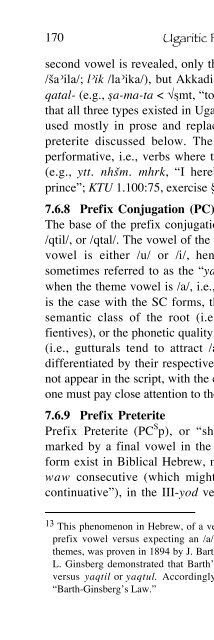A Primer on Ugaritic: Language, Culture, and Literature - enenuru
A Primer on Ugaritic: Language, Culture, and Literature - enenuru
A Primer on Ugaritic: Language, Culture, and Literature - enenuru
You also want an ePaper? Increase the reach of your titles
YUMPU automatically turns print PDFs into web optimized ePapers that Google loves.
170<br />
<strong>Ugaritic</strong> <str<strong>on</strong>g>Primer</str<strong>on</strong>g><br />
sec<strong>on</strong>d vowel is revealed, <strong>on</strong>ly the type qatil- is attested (e.g., sû}il<br />
/sûa}ila/; l}ik /la}ika/), but Akkadian provides examples of the type<br />
qatal- (e.g., sa-ma-ta < smt, “to transfer real estate”). We assume<br />
that all three types existed in <strong>Ugaritic</strong>. The Suffix C<strong>on</strong>jugati<strong>on</strong> was<br />
used mostly in prose <strong>and</strong> replaces, to a great extent, the prefix<br />
preterite discussed below. The suffix form also serves as the<br />
performative, i.e., verbs where the acti<strong>on</strong> is part of the utterance<br />
(e.g., ytt. nhsûm. mhrk, “Ihereby give serpents as your brideprince”;<br />
KTU 1.100:75, exercise §6.4).<br />
7.6.8 Prefix C<strong>on</strong>jugati<strong>on</strong> (PC)<br />
The base of the prefix c<strong>on</strong>jugati<strong>on</strong>s in the G-stem is either /qtul/,<br />
/qtil/, or /qtal/. The vowel of the prefix is a when the theme (stem)<br />
vowel is either /u/ or /i/, hence, the prefix c<strong>on</strong>jugati<strong>on</strong>s are<br />
sometimes referred to as the “yaqtul.” But the prefix vowel is /i/<br />
when the theme vowel is /a/, i.e., }il}ak /}il}ak/, “I will send.” 13 As<br />
is the case with the SC forms, the PC theme vowels indicate the<br />
semantic class of the root (i.e., /a/ for statives, /i/ or /u/ for<br />
fientives), or the ph<strong>on</strong>etic quality of the sec<strong>on</strong>d or third root radical<br />
(i.e., gutturals tend to attract /a/). The prefix c<strong>on</strong>jugati<strong>on</strong>s are<br />
differentiated by their respective endings, which unfortunately do<br />
not appear in the script, with the excepti<strong>on</strong> of the energic /n/. Thus,<br />
<strong>on</strong>e must pay close attenti<strong>on</strong> to the c<strong>on</strong>text of a form in a text.<br />
7.6.9 Prefix Preterite<br />
Prefix Preterite (PC S p), or “short Prefix C<strong>on</strong>jugati<strong>on</strong>,” is not<br />
marked by a final vowel in the singular. Remnants of this short<br />
form exist in Biblical Hebrew, most notably in poetry <strong>and</strong> in the<br />
waw c<strong>on</strong>secutive (which might have originated as a “preterite<br />
c<strong>on</strong>tinuative”), in the III-yod verbs (e.g., NRbˆy vs. h‰nVbˆy), <strong>and</strong> in the<br />
13 This phenomen<strong>on</strong> in Hebrew, of a verb with an /a/ theme vowel taking an /i/<br />
prefix vowel versus expecting an /a/ prefix vowels for verbs with /i/ or /u/<br />
themes, was proven in 1894 by J. Barth. In 1939, <strong>on</strong> the basis of the }-signs, H.<br />
L. Ginsberg dem<strong>on</strong>strated that Barth’s Law operates in <strong>Ugaritic</strong>. Thus, yiqtal<br />
versus yaqtil or yaqtul. Accordingly, the law is now generally known as<br />
“Barth-Ginsberg’s Law.”


